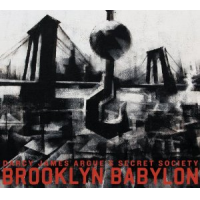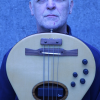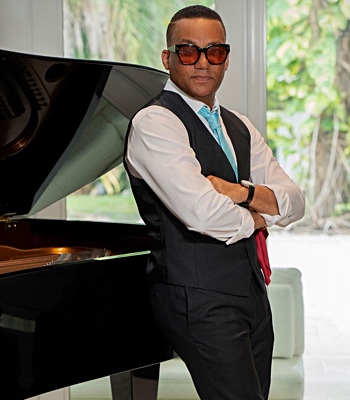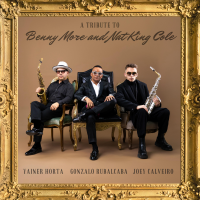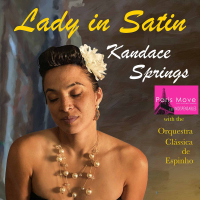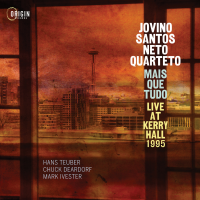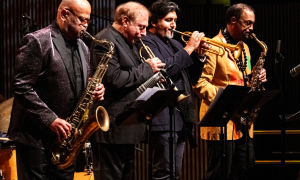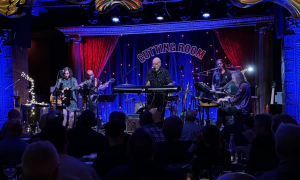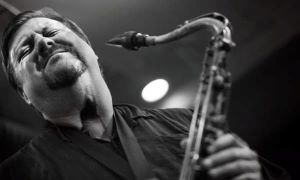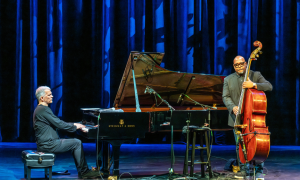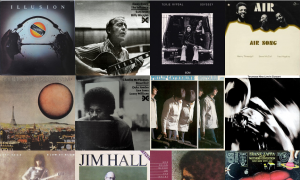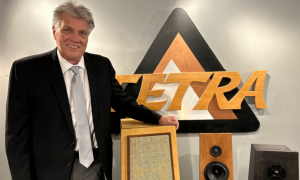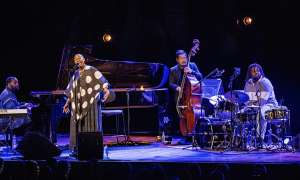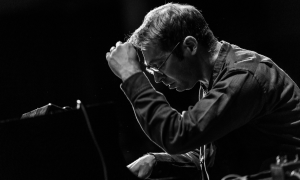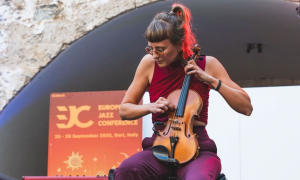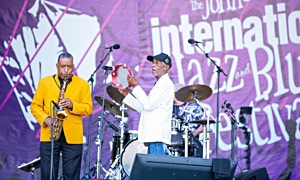Home » Jazz Articles » Live Review » Bray Jazz Festival 2013
Bray Jazz Festival 2013
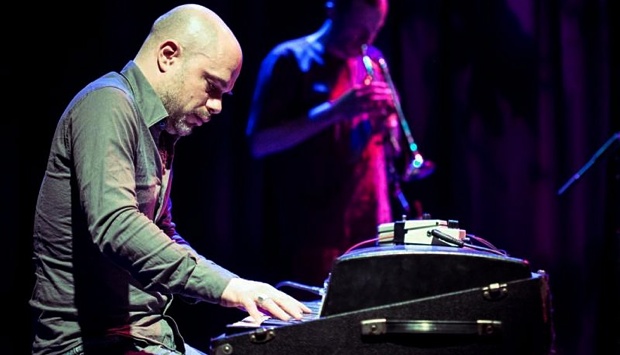
Bray, County Wicklow
Ireland
May 3-5, 2013
For many years, the picturesque town of Bray's main claim to fame has been that it's the oldest inhabited seaside town in Ireland. That is, it was the main claim to fame until Bray local lass Katie Taylor won boxing gold at the 2012 Olympic Games in the lightweight division, emptying the pubs of Guinness on that heady August day and forever putting Bray well and truly on the map. The Bray Jazz Festival, which was celebrating its 14th edition over the Bank Holiday weekend Festival, is also doing its bit to spread the name of Bray far and wide. It may not be the biggest jazz festival in the world, but like Katie Taylor, Bray Jazz packs a hell of a punch.
Festival organizers George and Dorothy Jacob have overseen the growth of the Bray Jazz festival from a small, relatively local concern to an international festival that attracts some of the most renowned figures in contemporary jazz. Since All About Jazz last covered the Bray Jazz Festival in 2009 the Irish economy has struggled and as George Jacob said, as he welcomed the opening night crowd: "It seems like a bit of a miracle that we're able to put on the festival year after year."
Divine intervention in aid of Bray Jazz, if it's there, is bolstered by support from the Arts Council of Ireland, Bray Town Council and the council of County Wicklow, the National Tourism Development Authority (Fáilte Ireland), national radio (RTE) and the local tourism board. It is their commitment in the main that ensures that the festival survives from year to year. No less significant is the support that comes from the town itself—festival flyers in shop windows, old loudspeakers in the high street pushing the festival. This year pubs, restaurants and hotels played host to over 30 high-quality bands—a record participation for the festival.
There were a couple of important innovations in this year's program. Firstly, in a brazen challenge to the heavens, an outdoor concert was held for the first time, or better said, a festival within the festival, as the Civic Plaza showcased four bands in a five-hour celebration of Balkan music, with musicians hailing from Serbia, Russia, Turkey, Italy, Ireland and the UK. Secondly, an educational workshop was staged, also for the first time. All in all, 44 concerts were held over the three days, and to everyone's delight the sun came out and shone over the entire weekend, prompting one local to say: "I haven't seen sign of that since last September."

The Bray Jazz Festival 2013 got underway on Friday evening with a strong double bill at the Mermaid County Wicklow Arts Center featuring Christy Doran's New Bag and Mederic Collignon Le Jus de Bocse.
Chapter Index
Christy Doran's New Bag
Médéric Collignon Jus de Bocse
Hopa! Carnival of Balkan Music/Norrland
Mats Eilertsen/Mama Rosin
Workshop/New Jazz Showcase
Brass Jaw/Eliane Elias/Michael Buckley
Christy Doran's New Bag
For guitarist Doran this was something of a homecoming, as he was born just down the road in Greystones, moving to Switzerland while still young. Since the 1970s, Doran has played with some distinguished names in free jazz/avant jazz, including drummer Han Bennink, bassist Jamaaladeen Tacuma, trombonist Albert Mangelsdorff, saxophonist Chico Freeman, multi-instrumentalist Marty Ehrlich, and pianist Carla Bley.
New Bag has been Doran's longest continuous musical concern, and has recorded 8 albums since 1997. Although the line-up has changed over the years the common denominator has remained Doran's eclectic, jazz-rock aesthetic. This incarnation of New Bag featured drummer Lionel Friedli, vocalist Sarah Buechi and Vincent Membrez on minimoog and Rhodes, and they gave a thrilling performance that drew mainly from Mesmerized ( Double Moon records, 2013).
The first two tracks, however, came from Take the Floor and Lift the Roof (Double Moon Records, 2011); "Embarkation" charged out of the blocks with post-punk energy. Whether singing lyrics or improvising, Buechi was a compelling presence, her utterly distinctive voice going through some arresting gymnastics. A ruminative, quasi-psychedelic passage led by guitar and Rhodes segued into a foot-to-the-floor workout with Doran's innovative guitar lines-cum-riffing at the heart of things. "Take the Floor and Hit the Roof" followed with the propulsive groove of 1980s King Crimson and featured a biting solo from Doran that was part Jimi Hendrix, part James Blood Ulmer.
Doran and Buechi share a fascination with Indian music and this was felt in the singer's delivery on "The Other Side of the Fence," which swung between hard groove and a minimalist passage where ethereal vocals and keys floated in tandem. The short and punchy "Techno Sketches" featured Buechi's most outré improvisations, and tight melodic unison lines from the singer and Doran. "Three Punk Chords Tango" came from a post-punk rock mold with Doran's wild sonic sculpting driven by a drum barrage and heavy keyboard riffs.
The quartet's lean sound owed something to the absence of a bassist, a role filled by Membrez and Friedli combined. The drummer's bass drum fired a constant pulse and his animated playing throughout was tremendously exciting, particularly during an extended exchange with Membrez on "Mesmerized"—a powerful vocals-driven number that grew relentlessly in intensity. The plot of "Long Distance Runner" took a few turns; tight unison playing, alternating sung and spoken passages, and an exhilarating finale that saw Doran solo with inspired abandon. Returning to the head, Buechi and Doran's lines fused as one and the quartet burst through the finishing line.
New Bag was an inspired choice of opening act for the festival and its incendiary performance will go down in the annals of Bray Jazz Festival's history.
Médéric Collignon Jus de Bocse
Médéric Collignon, pocket trumpeter and improvising vocalist, is well known in France for the diversity of his projects, and for his showmanship. Besides collaborating with some of France's top jazz musicians, like clarinetist Louis Sclavis, saxophonist/clarinetist Michel Portal and violinist Didier Lockwood, Collignon has collaborated in various art forms including dance, theater and comedy. During his performance at the Mermaids Arts Center these diverse influences were exhibited in his jumping about the stage, his gesticulations, mugging and comic asides. Collignon, as the audience was witness to, is the complete entertainer.

With his quartet Jus de Bocse, Collignon has revisited two extremes of trumpeter Miles Davis oeuvre; his collaboration with Gil Evans on Porgy and Bess (Discograph, 2006) and Davis' first electric period from the late 1960s to the mid-1970s on Shrangri-Tunkashi-La (Plus Loin Music, 2010). It was to Davis' jazz-rock/funk that Jus De Bocse turned its attention on Friday evening, and it wasn't for the faint-hearted.
Almost inevitably, Collignon sounded a lot like Davis, but there was no escaping the power and skill in his improvisations during the colossal half-hour opening segment, which began from a simple bass funk motif. Pools of introspection—with keyboardist Mathieu Jerome and Collignon hanging ethereal clusters of notes in the air—were but oases in an enveloping wall of sound. Collignon let rip with a series of searing runs, that together with drummer Philippe Gleizes' unrelenting barrage could have woken the dead.
"Ife" began with Collignon's vocal improvisation, part beat-box, and part impersonation of distorted guitar and muted trumpet. With the bass motif gathering strength, the quartet was soon firing on all cylinders and the intensity only seemed to grow over the course of the next thirty five minutes. A breathless vocal improvisation married Collignon's hyper take on konnakol and an array of odd noises, ranging from Frank Zappa-esque comedy and heady sci-fi soundscapes to urban beatbox rhythms. With pocket trumpet in hand again, Collignon led the quartet in the theme to "Interlude," in a blistering climax to a powerful show.
After two such adrenaline-pumping shows only a pint or two of the dark stuff could reduce the excitement levels sufficiently to allow sleep, and there were plenty of pubs in Bray still serving up the black medicine. Over at the Martello Hotel, the Max Zaska Trio was holding the attention of a small pocket of the packed bar with a polished set of standards. Guitarist Zaska impressed not only with his technique but with his melodic improvisational flow. His style leaned towards a straight ahead John Scofield and he was ably supported by double bassist Baz Rycraft and drummer Satya Darcy.
All three musicians are products of Dublin's Newpark Music Center—the only institution in Ireland to offer a jazz program— and Rycraft described his studies there as intense but "life changing." During the three days of Bray Jazz 2013 a large number of Newpark music students and graduates of a very high level of competence—and confidence—turned up on the festival program, suggesting that there's jazz talent aplenty in Ireland. However, given the real dearth of jazz venues the trend seems to be for young musicians to pack their bags and head across the water to London, or over the bigger pond to New York and Boston.
When seen in this light, the number of foreign jazz musicians who have made Ireland their home in the immigration wave of the past two decades has helped not only to maintain jazz as a live entity, but to diversify the type of jazz being played and listened to.
Hopa! Carnival of Balkan Music/Norrland
There were foreign musicians galore to kick start day 2. A temporary stage was the centerpiece of the Civic Plaza on Saturday where musicians from Serbia, Russia, The Ukraine, Turkey, Italy, Ireland and the UK treated the crowds to a feast of Balkan music. The free "festival within a festival" entitled Hopa!, was the first stab at an outdoor event during the 14-year history of the Bray Jazz Festival and it proved to be a resounding success with the public.
Four bands, Paprika,Yurodny, She' Koyokh and North Strand Kontra Band blew tubas and trombones, exhausted fiddle strings, sang and danced for five hours, pulling the crowd into the celebration along the way. Paprika violinist Bogdan Vacarescu was one of several standout virtuosos on the day, but he lamented the fact that the quartet should have been a sextet but for the fact that the band's two London-based Serbian accordionists, Milos Milivojevic and Zivorad Nikolic hadn't received their performance visas in time to travel.

North Strand Kontra Band did have an accordion, and banjo, saxophone, clarinet and trombone to boot. Its mixture of Serbian and Romanian tunes had the kids in the plaza dancing deliriously. Hemel Hempstead may seem an unlikely well-spring for Klezmer and Balkan music, but that's where She'Koyokh was founded in 2001 by violinist Susie Evans. Evans and Turkish singer Cigdem Aslam danced in the plaza and singer Paul Tkachenko conducted a crowd sing-along in Yiddish, surely another first for the BJF. Dublin-based Yurodny played a rousing set featuring virtuoso violinist Oleg Ponomarev, accordionist Francesco Turrisi and saxophonist/founder Nick Roth.
In a grandstand finish, an impossibly large number of musicians from all four bands joined together on the small stage to the delight of the crowd. The outdoor mini-festival succeeded on a number of levels, not least of which was the casual, carnival atmosphere, something with which jazz festivals are not always associated. The stroll in stroll out nature of the event throughout the afternoon drew probably upwards of a thousand people and no doubt did a lot to spread news of the BJF 2013 around town. In addition, the relaxed, fun atmosphere and the top-drawer musicianship on display may well stir the curiosity of a few first-timers when the BJF rolls round again in 2014.
The early evening concert in the Town Hall was an intimate affair by Swedish duo Norrland. Saxophonist Jonas Knutsson and guitarist Johan Norberg have recorded three albums of music drawing from the rich Swedish folk tradition. The last of these was Skaren: Norrland III (ACT Music, 2008) but they continue to perform live whenever their respective schedules permit. With the last rays of the evening sun illuminating the stained-glass windows of the Town Hall chamber, there was a suitably relaxed and quiet atmosphere for such hauntingly beautiful music.
In the main, Knutsson's saxophone carved the principal melodic lines with Norberg plying intricate accompanying lines. Century-old polskas, and compositions inspired by towns and nature provided the inspiration for the duo's intimate dialogs. After one particularly pretty polska dating from the 19th century, Norberg said: "That's the beauty of a beautiful melody—it never dies." In explaining the Swedish folk musician's relationship with his or her subject matter, Norberg said: "We don't sing about the lake, we sing the lake."
One Swedish musician who did much to revive interest in old Swedish polskas and herding songs was pianist Jan Johansson, whose duo album with bassist Georg Riedel, Jazz Pa Svenska (Megafon, 1964) continues to have an influence far beyond the confines of Sweden to this day. Johansson and Riedel's interpretations of folk songs were jazz tinged, an idiom that was essentially absent from Norrland's interpretations. Norberg pointed out that playing their own traditional music with improvisation, yet without the blueprint of the American blues or jazz felt like "a kind of freedom."
Having said that, Norberg's strings betrayed a distinctly bluesy feel on the last two numbers, though as this was a performance before a typically open-minded Bray jazz crowd and not the elders from the Society for the Preservation of Swedish Folk Tunes, nobody minded.
Mats Eilertsen/Mama Rosin
The headlining gig of day two in the Mermaid Arts Center was Mats Eilertsen Skydive. Bassist Eilertsen is one of the quietly unsung stars of the Norwegian jazz boom. He's the go to guy for an increasing number of musicians, such as trumpeter Tomasz Stańko, guitarist The Jacobs Brothers, pianists Tord Gustavsen and Wolfert Brederode and singer Solveig Slettahjell. In addition, and without much fanfare, he's made half a dozen recordings as leader of compositional depth and beauty. The set showcased tracks from Skydive (Hubro, 2011) and 18 months of gigging since its release can only have tightened the group interplay.
Saxophonist Tore Brunborg got "Momento" under way, with pianist Alexi Tuomarila, drummer Olavi Louivuori, guitarist Thomas Dahl and Eilertsen following closely in the melody's slipstream. After five minutes of feeling their way together, passing the lead around in short improvisational gestures, Eilertsen's gentle bass ostinato steered the quintet into more clearly definable space. Guitar and saxophone in turn imposed melodic lines before a more expansive piano solo raised the group tempo. Dahl and Brunborg picked up the reins, and in contrast to the feathery impressionism of the intro, they both soloed strongly and with a clear sense of destination.
"Wheel" paid homage to trumpeter Kenny Wheeler, and if not obviously inspired by the legendary Canadian/British figure, its soulful melody, stemming from and woven around a delightfully simple piano and bass motif, was as deceptively simple and graceful as many of Wheeler's own melodies. Louhivuori's deft percussion served as a bridge to an extended mood piece that eschewed solos for overlapping layers of sound. Eilertsen's unaccompanied solo, folk and classically colored, was seductively lyrical and paved the way for a more rhythmic group dynamic. Tuomarila and Thomas' animated solos were consistently melodic.

A tribal-esque drum pattern and rhythmic guitar initiated a groove-based new number, with Brunborg and Tuomarila taking their liveliest solos of the set. "Skydive" was a subtle tone poem of gentle lyrical patterns, with Dahl's sotto voce playing central to the number's subdued atmospherics. "Bravo" built around a steady pulse, and it was the mood that this insistent groove conjured that defined the piece more than Brunborg's melodic lines. The last number was characterized by brooding abstraction that ebbed and flowed until bass and drums found a groove, propelling Brunborg towards another charged solo. The encore, described by Eilertsen as "a Norwegian folk song from the '80s" began as gently as a lullaby. With Eilertsen's bass pulse strengthening, the piece briefly found wings but almost inevitably it returned to the hushed terrain of the intro before fading out.
Norway has produced a disproportionate amount of exceptional jazz in the last two decades and there seems to be no end to the stream of innovative musicians. The Bray Jazz Festival has kept an eye on the Norwegian scene for some years now, staging memorable concerts such as the Mathias Eick Quartet, the Tord Gustavsen Trio, Mari Kvien Brunvoll and Trygve Seim & Frode Haltle. Mats Eilertsen Skydive is the latest to grace the BJF and judging by the audience's response, more Norwegian jazz artists wouldn't go amiss.
The late night concert, kicking off at midnight in the the Martello Hotel, featured the Cajun/Zydeco trio Mama Rosin. Having just arrived the day before after a tour of America, vocalist, guitarist and banjo player Robin Girod, accordionist/vocalist Cyril Yeterian and drummer/vocalist Xavier Bray could have been forgiven for a little jet-lag, but if they were feeling any wear and tear they certainly didn't show it during a high-energy performance full of verve and swagger that had the crowd dancing throughout.
Four albums in, Mama Rosin have become something of a world-wide phenomenon, performing from Chengdou to Lafayette, and from Basel to Bray. The trio's infectious rhythms came from the traditional frottoir—Cajun washboard—and on a couple of numbers a triangle. The tireless collective energy was a big part of the show, but there was no escaping the quality of the songs, mostly taken from the band's CD Bye Bye Bayou (Moi J' Connais Records, 2012), nominated for Best Alt Country Album of the Year by the Independent Music Awards.
Cajun, Zydeco and rhythm & blues were all in the mix and watching the trio bob and sway on the stage, high on their own melodies and rhythms, drunk on their wilder improvisations, was a joy. This was roots music at its danceable best.
Workshop/New Jazz Showcase
The final day of the Bray Jazz Festival began with a workshop by Scottish four-piece, Brass Jaw. This was the first time in the festival's 14-year history that an educational workshop was held in Bray, though in 2002 saxophonist Steve Coleman gave a master class at Newpark, Dublin. The long gap between such events has little to do with the organizer's desire to stage educational workshops and much more to do with funding limitations and logistics: "It's been necessary in recent years to concentrate the funding granted on maintaining the core element of performances by international and Irish groups," George Jacob explained, "to maintain the reputation and quality of the festival programme." However, thanks to the support from Music Generation Wicklow and Brass Jaw, a workshop went ahead this year and it proved to be a great hit with young musicians just starting out on their instruments.
The venue was The Well, a church formerly of the Church of Ireland. When a bigger church was built at the top end of the town in the 1970s, the church became a "church of ease"—church speak for out of service. The church then became home to a local piano maker until a few years ago when Pastor Nigel Reid brought spiritual life back to the building. Instead of baptizing it the Church of This or the Church of That, he opted for the much more enigmatic name, The Well. As Pastor Reid explained, the name was inspired by Jesus words to a Samaritan woman at a well in Sychar, as told in the Book of John. "It [the church] is like a well," said Pastor Reid, "where people come to drink spiritually." This particular Sunday, however, was the church's baptism of jazz.

About seventy people of all ages came to Brass Jaw's workshop and quite a few will have left with another kind of enlightenment, after an engaging and highly enjoyable 90-minute session, whose aim, in a nutshell, was to demystify jazz. Brass Jaw is trumpeter Ryan Quigley, alto saxophonist Paul Towndrow, tenor saxophonist Konrad Wiszniewski and baritone saxophonist Allon Beauvoisin. This Scottish band's roots go back to 2005 and they were Ensemble of the Year in the UK Parliamentary Jazz Awards in 2011. By way of introduction the quartet played keyboardist Joe Zawinul's "Walk Tall"—a storming version that hooked the audience from the first.
In the center of a circle, the four musicians talked of their entry into jazz, their first steps in approaching, and eventually coming to grips with their instruments. They then invited volunteers to step forward with their own instruments. Three saxophones, a trumpeter, a guitarist and two fiddlers formed a line and joined in the improvisation lesson. Others were invited to conduct the mini-orchestra, and with everyone blowing, including the Brass Jaw quartet, the heady, beautiful cacophony had just a hint of an iconoclastic Charles Mingus celebration. This communal achievement alone made the workshop a success, and huge fun too.
The young trumpeter, who initially had been reluctant to join the line, found his voice and blew with some confidence. If the workshop managed to increase these aspiring musicians' levels of confidence and gave them a building block or two to progress with—and watching from the sidelines it appeared to have done just that—or if it managed to bolster self-esteem just a little, then it will have made a strong case for making such educational workshops an integral part of future editions of the BJF. Jesus would surely approve into the bargain.
Just across the road from The Well at the Royal Hotel, the New Jazz Showcase presented three Dublin bands in the early afternoon. The Multiverse is the new trio project of Cork-based Congolese singer/ guitarist. Niwel Tsumbu. A well known figure in jazz and creative music circles in Ireland since he arrived in 2004, Tsumbu has played in a wide-ranging number of projects with top local musicians. Currently, he can be found in The New Triangle alongside pianist/composer Roger Doyle and singer/cellist Vyvienne Long, exploring the meeting points of classical, African and folk traditions. Multiverse, with drummer Shane O'Donovan and bassist Peter Erdei, expands on a tradition of alternative jazz-rock ensembles that includes those led by guitarists James Blood Ulmer and Sonny Sharrock.
In an absolutely electrifying performance, Tsumbu caressed his strings to produce lighter-than-air Bill Frisellian sounds in moody, abstract passages, and attacked them with the fire and fluidity of Jimi Hendrix, sympathetically supported by O'Donovan and Erdei. His vocabulary, drew from his African roots, jazz, rock and folk in more or less equal measure and the integrated whole produced a fascinating language, delivered with intensity and passion. The crowd responded enthusiastically and the only disappointment was to learn that Multiverse hasn't as yet recorded a CD.
Butter was described in the program as playing classic neo-soul and hip-hop covers but the sextet, led by singer Georgia Cusack, had a lot more than that going on. Soulful, yes, courtesy of Berklee-trained Cusack and the tightly locked horns of tenor saxophonist Sam Comerford and alto saxophonist Chris Engel, but the intensity at times in the collective voice and a large dose of improvisation from the saxophones and guitarist Stephen McHale, lent an exciting contemporary jazz feel to the music. Drummer Dennis Cassidy and bassist Stephen Maynard Smith kept a tight groove when required but also enjoyed the freedom that was an inherent part of this exciting band's performance. Butter's original arrangements of well known tunes—and others more obscure—and the obvious chemistry among the musicians suggests that this band will be a strong draw throughout Ireland. Once it gets some original tunes under its belt there'll be no holding it back.
The third band of the New Jazz Showcase was Phisqa. Phisqa means five in the Quecha language of Peru and refers to the five members of the quintet, Italian guitarist Julien Colarossi, South Africa saxophonist Chris Engel, Irish double bassist Cormac O'Brien, Venezuelan pianist Leopoldo Oslo and drummer/percussionist and leader, Peruvian, Cote Calmet. With such a cosmopolitan line-up a 'world' jazz or jazz-fusion might have been expected, and whilst African, Latin and even flamenco accents surfaced at times, the various influences were successfully subsumed in a fairly straight ahead aesthetic, though one brimming with bravura.
That said, Cote's Peruvian rhythms on drums and cajon lent a distinctive other flavor to the music. Featuring songs from the quintets debut CD, Phisqa (Self Produced, 2013), Calmet's strong writing was as evident as the impressive individual musicianship. The leader swapped his drums for charango—Andean lute—on the intro to "Ayarachi" before the piece settled into the flowing contemporary jazz mode that characterized the entire gig. Oslo, Colarosi, Engel and Cote all stretched out with telling solos. The stirring number ended serenely with Cote on charango again, accompanied by Engel on soprano saxophone.
The New Jazz Showcases have become a popular feature of the BJF over the past four editions, and four hundred people attended the free concerts this time around: "The plan is to include this in the festival each year," Dorothy Jacob said. "It's important to contribute to the development of jazz in Ireland." These three excellent bands provided a cross-section of the range of jazz talent that Ireland currently boasts. The enthusiasm of the mixed-aged audience for all three bands was also a sign that the Bray/Dublin jazz fan is as open-minded towards innovation and diverse influences as the musicians themselves.
Brass Jaw/Eliane Elias/Michael Buckley Band
The Town Hall evening concert saw Brass Jaw give a memorable performance full of humor that combined intricate four-way harmonies and individual virtuosity. The quartet entered the hall playing and left the same way. For an hour and twenty minutes in between they played tunes that went from the short and punchy "Duck's Chickens" to a four-part suite, Ryan Quigley's "Imaginary Friend." There was rhythm 'n' blues in an exhilarating version of "Walk Tall," which saw the musicians bobbing backwards and forwards over a baritone riff and a ripping tenor saxophone solo. Quigley's muted trumpet raised the spirit of New Orleans on the soulful "Charles Franklin Blues" whereas the more contemporary "Talisman Home" referenced the influence of composer Phillip Glass.

The quartet slowed things down on the Rogers & Hammerstein tune "Little Girl Blue." Though the more up-tempo tunes were highly entertaining, the slower numbers afforded better opportunity to appreciate the intricacies of the quartet's shifting harmonic layers. This was true of "I Can Hear Your Smile," a modern classical composition of hymnal elegance. But Brass Jaw aims to entertain and the infectious funk-jazz of "Siddhartha" would have made a great alternative soundtrack to the 1970's cop show "Starsky and Hutch." A roaring version of The Beatles' "Drive My Car" and Bobby Hebb's much-covered "Sunny" concluded a marvelous set in upbeat manner. Brass Jaw's innovative and fun approach to traditional/popular music was refreshing. The versatility, sophistication and sheer energy in its performance was remarkable.
The evening concert at the Mermaid County Wicklow Arts Center was Brazilian singer/pianist Eliane Elias. With husband and bassist Marc Johnson and guitarist Steve Cardenas making up the vastly experienced trio, expectations were high for a memorable concert. Indeed, the organizers could have sold the concert out twice over, and a number of disappointed ticketless fans were turned away on the night. The concert began half an hour later than advertised but the reception given Elias, Johnson and Cardenas when they took to the stage signified that all was right with the world.
As one, the trio launched into Arthur Schwartz' composition and jazz standard "You and the Night and the Music." Elias, like most of her peers, has long been influenced by pianist Bill Evans recorded this number on Something for You: Eliane Elias Plays and Sings Bill Evans (Blue Note Records, 2008). And with Johnson, who was Evan's bassist for the final two years of his life, providing the fulcrum for the trio, the spirit of Evans was strongly present. Elias, however, is no clone and her take on this and the set's other standards bore her personal stamp, notably a Brazilian tinge on a swinging version of "There Will Never Be Another You" and a bluesy take on "I Thought about You."
Only a couple of Brazilian classics graced a set dominated by standards; a delightful version of Gilberto Gil/João Donato's "Bananeira" and Antonio Carlos Jobim's "So Danco Samba" being highlights. With a new album due in tribute to trumpeter/singer Chet Baker, Elias performed several tunes recorded by him. Introducing "This Can't Be Love," Elias spoke of falling in love with Baker's music at the age of 10, in particular his trio with pianist Red Garland and bassist Paul Chambers. Her renditions of tunes closely associated with Baker, "Everything Depends on You" and "Just Friends" were evidently heartfelt. "Everything Depends on You" was an intimate duo rendition between Elias and Cardenas.
One new composition, "Stairway to the Ninth Dimension" involved a little light-hearted interaction with the audience, but levity aside it contained some of the most adventurous soloing of the set from both Elias and Cardenas. Between numbers Johnson also treated the audience to a lyrical five-minute solo. In general, however, the trio's performance lent more towards song interpretation rather than repetitive displays of virtuosity, though everyone blew off plenty of steam on "Bowing to Bud," Elias' celebratory tribute to pianist Bud Powell. It ended a classy, highly enjoyable set on a high note, though the inevitable encore brought one more round from Elias, Johnson and Cardenas—and a standing ovation from the audience.

The honor of closing BJF 2013 fell to one of Ireland's leading jazz figures, saxophonist Michael Buckley, who led his nine-piece Michael Buckley Band at the Martello Hotel, from midnight until well after 2 in the morning. Fronted by singer Margot Buckley, the band's lively set mixed soul, funk and more straight ahead fare from Buckley's current release, It is What it is (LYTE Records, 2013).
Essentially unpretentious, good-time music, there was warmth in the tight horn arrangements and in Margot Buckley's soulful delivery. The between-songs banter was entertaining, but as lighthearted as the gig was, there was still plenty of fire from Buckley and guitarist Mal O'Brien. A healthy crowd was still standing at the end to give Buckley and band a deserved and enthusiastic ovation.
The BJF 2013 did what it always does by serving up nothing but good music for three days. The jazz was about as varied as it's possible to get these days, covering a wide range of styles, electric and acoustic, modern and traditional, from Brazil to Scotland, from Sweden to France and from Norway and Switzerland to Ireland. Balkan and Cajun music, whilst not exactly jazz, did throw up plenty of exciting improvisation and certainly enlivened the festival no end. The success of the outdoor concerts on the Saturday, the educational workshop and New Jazz Showcase gigs on the Sunday, all point the way forward for the BJF.
Although George and Dorothy Jacob have had to trim the BJF program a little in recent years due to the ongoing recession, there has been no compromise in the quality of the music and in their vision to develop the festival and bring jazz to greater numbers of people. If, as George Jacob said, it's been a miracle to keep the festival going year after year, it's exciting to imagine what it could be like when the economic good times roll round again, as they surely must.
Photo Credits
Page 2: Hopa! Page 3: Brass Jaw Workshop Ian Patterson
Page 3, Mats Eilertsen:Robert Goode
All Other Photos: Courtesy of Dublin Jazz Photography/Bray Jazz
Tags
PREVIOUS / NEXT
Support All About Jazz
 All About Jazz has been a pillar of jazz since 1995, championing it as an art form and, more importantly, supporting the musicians who make it. Our enduring commitment has made "AAJ" one of the most culturally important websites of its kind, read by hundreds of thousands of fans, musicians and industry figures every month.
All About Jazz has been a pillar of jazz since 1995, championing it as an art form and, more importantly, supporting the musicians who make it. Our enduring commitment has made "AAJ" one of the most culturally important websites of its kind, read by hundreds of thousands of fans, musicians and industry figures every month.


